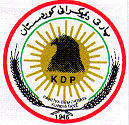





Geography, politics and history have conspired to render 30 million Kurds the largest stateless people in the Middle East. With their state taken away from them by the Turks, the Kurds developed into permanent minorities in Turkey, Iraq, and Iran. In all three of these countries they founded political movements seeking varying degrees of autonomy with the same variety of results. The Kurdish Democratic Party (KDP), under the leadership of Mullah Mustalafa-al-Barzani, formed in 1946 inside the Soviet occupied land in Northern Iran. Mullah established a territory in this region called the Republic of Mahabad.
In northern Iraq, the Kurds took advantage of the expanding commerce in the 1960�s resulting from Iran and Iraq�s boom in the oil trade. The Kurd's dependency on the short land routes to Europe they held land on, increased as the Iraqi economy grew. In 1963 the Ba�ath party, led by Saddam Hussein, took control of Iraq. The Ba�ath, or as translated into English, renaissance movement did not confine itself to the nation of Iraq. Syria and Egypt also proposed embracing this movement calling for Arab nations to unite as one. This movement arrived at a time when the blame for failures of the Arab states fell upon corruption and Kurdish uprisings. These convictions led Ba�ath sympathizers in Iraq to continually seek the genocide of the Kurdish race. The arrest of a negotiating team from the KDP in June 1963 and the commencement military campaigns against the KDP forces by the Iraqi army validated these views.
With neither side achieving complete victory, Saddam Hussein suspended the seven years of bloody military operations with a negotiated deal with the KDP leadership. This agreement accepted the fact the Iraqi people consisted of two "primary" nationalities, the Arabs and the Kurds, and established the Kurdish language as the second national language of Iraq. Furthermore, it established an autonomous region to be formed within four years of the signing of the agreement. A failed assassination attempt of KDP leader General Mullah Mustafa Barzani, blamed first on the PUK but later found to be the work of the Baghdad regime, caused the plans for a Kurdish state to deteriorate rapidly. The end of the four year period following the signing of the agreement came and went. Eventually, the best effort made by Baghdad effectively limited Kurdish autonomy to executive and legislative councils at the local level.
Infuriated, the KDP responded with guerrilla attacks on Iraqi government forces and installations with support by Iranian, US, and Israeli sources. The support conceived an overconfidence by the KDP to believe they would succeed in a conventional campaign against the Iraqi military. This assumption proved disastrously wrong, and the superior forces of Iraq drove the KDP forces across the Iranian border. Baghdad took further advantage of this victory by reducing Kurdish political influence in Iraq while relocating Kurdish people into a shrunken autonomous region.
On 21 September 1980, Baghdad turned its attention to the war started with Iran, and the KDP took advantage of the situation to side with Iran. Eventually Saddam, losing the war, needed to seek a separate peace with the KDP but failed. He then turned to the PUK in 1984 seeking a settlement and, in desperation, had to offer terms even more generous than those of the 1970 agreement with the KDP. But this too never reached ratification due to influence by the Turkish Prime Minister, whose country opposed the expansion of power to the Kurds. As a result, Baghdad broke off the talks and fighting resumed.
After Baghdad achieved victory over the Kurdish people in 1988, the Iraqi military continued to attack the Kurds in a campaign Baghdad dubbed "Anfal," based on the eighth Sura, or verse, in the holy Quran meaning the "spoils of war." This campaign proved more ruthless than those conducted between 1964 and 1975. In addition to the demolished villages, firing squads, mass graves, and various other atrocities, the Iraqi military attacked the Kurds with poison gas in the town of Halabja. The attack occurred on 16 March 1988 with a deadly mixture of chemical weapons to include mustard gas, sarin, tabun, and VX nerve agent. These were delivered over a three day period and left over 5,000 dead and 30,000 injured. Halabja proved to be the largest, but not the only, Iraqi Kurdish town attacked with chemical weapons. The 24 years of campaigns against the Kurdish people by Iraq resulted in over 4,000 villages destroyed and as many a 250,000 Kurds reported killed.
In northern Iraq, all central government functions have been performed by local administrators, mainly Kurds, since the Government withdrew its military forces and civilian administrative personnel from the area after the 1991 uprising. A regional parliament and local government administrators were elected in 1992. This parliament last met in May 1995. Discussions among Kurdish and other northern Iraqi political groups continue on the reconvening of parliament, but fighting between the PUK and KDP continue to prevent normal parliamentary activity.
In northern Iraq, fighting continued in 1997 between the two main Iraqi Kurdish groups, the Kurdistan Democratic Party (KDP) and the Patriotic Union of Kurdistan (PUK). In addition, attacks on civilians by the Turkish Kurd terrorist organization, the Kurdistan Workers' Party (PKK), resulted in many deaths, particularly among the vulnerable Assyrian minority and villagers who supported the KDP. Turkish forces entered Iraq several times during the year to combat the PKK. These separate conflicts converged in November, when Turkish air and ground elements joined the KDP to force the PUK and the PKK to return to the established intra-Kurdish ceasefire line. The fighting left over a thousand persons dead and forced thousands of civilians from their homes. A ceasefire established on 24 November 1997 ended the fighting for the remainder of the year, albeit with a few sporadic clashes.
The KDP estimated that 58,000 KDP supporters were expelled from Suleymaniyah and other PUK-controlled areas from October 1996 to October 1997; the PUK says that more than 49,000 of its supporters were expelled from Irbil and other KDP-controlled areas from August 1996 through December 1997. The U.N. reports that more than 10,000 persons were forced from their homes when fighting broke out between the Kurdish factions along their cease-fire line in October 1997.
The United Nations has documented over 16,000 cases of persons who have disappeared in the Iraqi sector of Kurdistan. According to the Special Rapporteur, most of these cases occurred during the Anfal Campaign. He estimates that the total number of Kurds who disappeared during Anfal could reach the tens of thousands. Human Rights Watch estimates that the total at between 70,000 and 150,000, and Amnesty International (AI) at more than 100,000.

